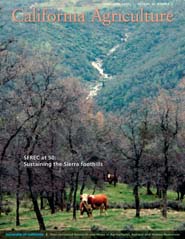All Issues

SFREC at 50:
Sustaining the Sierra foothills
Cover:
Deer Creek flows through the UC Sierra Foothill Research and Extension Center, where research on oak woodlands, rangeland, cattle management and water quality has flourished for 50 years. (Photo by Charles Raguse.)
April-June 2010
Volume 64, Number 2
Volume 64, Number 2





